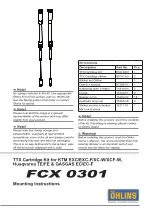
Product Service 1-800-522-7658
1
C
HAPTER
1
I
NTRODUCTION
Congratulations on your purchase of a Labconco Purifier
®
Passive PCR Enclosure
or Purifier Tissue Culture Enclosure. Your
non-ventilated
enclosure is designed
to reduce cross-contamination in laboratory applications.
The Purifier Passive PCR Enclosure and Purifier Tissue Culture Enclosure offer a
UV light for disinfecting the interior and an interior switched electrical outlet. The
Purifier Passive PCR Enclosure UV light has the added feature of a digital timer to
accommodate PCR protocol. To take full advantage of all the features, please
acquaint yourself with this manual and keep it handy for future reference.
Polymerase Chain Reaction (PCR)
Definition
Polymerase Chain Reaction (PCR), is a laboratory process in which a particular
DNA segment from a mixture of DNA chains is rapidly replicated, producing a
large, readily analyzed sample of a piece of DNA. In PCR, DNA is immersed in a
solution containing the enzyme DNA polymerase, unattached nucleotide bases (the
subunits that DNA is composed of), and “primers”, short sequences of nucleotides
designed to bind with an end of the desired DNA segment. Two primers are used:
one primer binds at one end of the desired segment on one of the two paired DNA
strands and the other primer binds at the other end but on the other strand. The
solution is heated to break the bonds between the strands of the DNA. When the
solution cools, the primers bind to the separated strands, and DNA polymerase
quickly builds a new strand by joining the free nucleotide bases to the primers.
When this process is repeated, a strand that was formed with one primer binds to
the other primer, resulting in a new strand that is restricted solely to the desired
segment. Thus, the region of DNA between the primers is selectively replicated.
Further repetitions of the process can produce billions of copies of a small piece of
DNA in several hours. PCR was developed in 1985 by Kary B. Mullis, who was
awarded the 1993 Nobel Prize in chemistry for his work. It is used in a broad






































